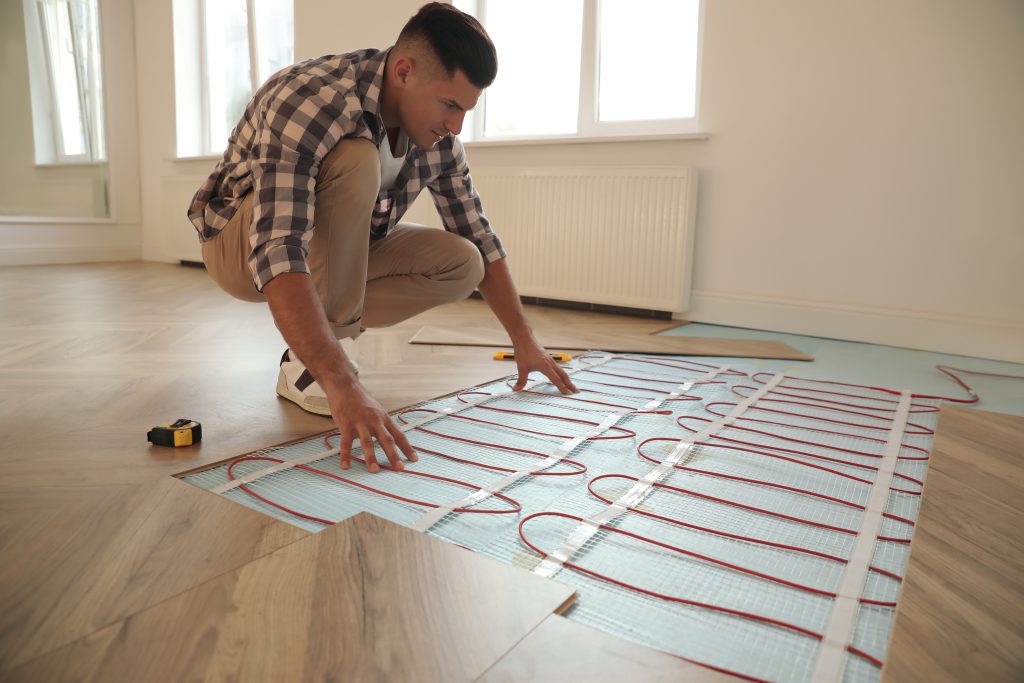GUIDE
Flooring for underfloor heating – everything you need to know
Ceramin

Underfloor heating in a house or flat requires suitable flooring that is designed for such installation. Under the influence of heating, the material constantly shrinks and expands, so flooring that has not been adapted to such conditions will quickly deteriorate. This is manifested by numerous bulges appearing on the floor or gaps between its elements. Therefore, by purchasing the flooring that is properly adapted to higher temperatures, you will avoid many problems and use a right solution that can withstand high temperatures.
Flooring suitable for underfloor heating does not differ externally from other models. The difference between them boils down to the specific properties. Therefore, when choosing the flooring for underfloor heating, you need to pay attention to the heat transfer coefficient. This is a parameter by which you can determine how well a material will release heat into the environment. Therefore, the lower the value of the coefficient, the more efficiently the flooring will emit heat. We should also pay attention to the thickness of the individual elements; thicker models are more durable than their thinner counterparts.
Flooring intended for the kitchen should, above all, be highly resistant to moisture and stains. The kitchen is the place where the floor is most likely to react with moisture, so it is worth preparing for such situations a little in advance. The best choice will be water-resistant laminate flooring, which has a resistance to standing water of up to 24 hours, or vinyl (composite) panels, which are 100% waterproof and water-resistant. The flooring for underfloor heating in the kitchen that is properly adapted is safe, because spilt liquid will not lead to swelling and damage to the floor before it is wiped. The kitchen is a place where we spend a lot of time and there is more traffic than in other rooms. Therefore, the flooring should also be resistant to abrasion and mechanical damage. In this case, when choosing, it is worth paying attention to the marking of the abrasion and usage class.
Underfloor heating is a very practical solution; here are the most important advantages that make it work well in many rooms:
The use of underfloor heating in rooms also comes with aesthetic values. Because the heating system is under the floor, there is no obligation to hang radiators on the walls, which could visually disturb the design. This gives you additional possibilities for the use of the walls, allowing you to design a harmonious interior.
It is worth knowing a few basic aspects that need to be taken into ache flooring for underfloor heatingcount when installing the flooring. This will ensure that t look aesthetically pleasing and perform its functions effectively. These include:
In the case of a narrow kitchen, the flooring should be installed widthwise to widen it optically. However, this type of work is much more time-consuming and requires exceptional precision and accuracy. In the case of crooked walls, the widthwise installation can be problematic and leave more waste. It is worth knowing that in such a situation you can also decide to lay the flooring along the longer walls. Then it will look much more aesthetically pleasing. In this case, the colour of the flooring should be matched to the colour of the walls.
The layer underneath is in direct contact with the heating system, so it is worth ensuring that it fulfils all the specified functions. It is what determines whether the heating will be efficient and effective. Unlike the flooring, the underlay should be thinner. It is worth choosing a material that is characterised by increased density. An important aspect when choosing a substrate is to match it to the type of heating. For example, in the case of water underfloor heating for the flooring, an underlay made of cork or quartz mat will work well. In addition to transferring the heat to the flooring without major losses, such underlay will also soundproof the floor, thus affecting the comfort of the household members.
To avoid difficulties later on, it is worth choosing the underlays up to three millimetres thick. Underlays integrated with the foil, which are designed to be used with underfloor heating for the flooring will be a perfect solution. When installing, it is worth considering the correct positioning of the flooring. Particular care should be taken to ensure that the expansion gaps are sufficiently wide. Under the influence of high temperature, the floor may naturally bulge, and small air cushions may impair heat transfer. It is also worth ensuring a solid and even screed. If this is the case, the flooring may also bulge. Remember, therefore, that for optimum heat transfer it is essential that the floor, substrate and the flooring adhere closely together.
Combining the flooring together with underfloor heating is an excellent and practical idea. It adds charm to the interior and makes the room feel cosy and warm. During autumn and winter, many people appreciate underfloor heating, because it makes staying in the room more pleasant. In addition, when it is wet and wintry outside, underfloor heating in the corridor ensures that shoes dry quickly, and feet get this pleasant warmth right away. Underfloor heating for the flooring also has many aesthetic advantages. Without the need for radiators, the interior looks harmonious and classy. The walls can be designed accordingly, and the smooth room gives an elegant and sophisticated feel.